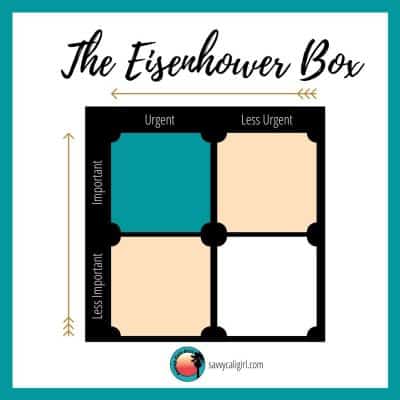Time management is a skill learned over time. Balancing family and work is a nightmare honestly. If you were disorganized as single person, marriage and kids just piles on. Add extended family or friends into the mix and it truly is a hot mess.
It may seem like you just can’t possibly to do it all, let alone do it well. So what happens? Do you throw in the towel? Heck no!
The old adage, work smarter not harder, should become a daily mantra but getting started is a big mountain to climb. Don’t look at the mountain, look at the first ten yards and just get started.
We have a number of posts related to productivity and/or time management, from a number of perspectives. They are linked at the end of this post for you. Today, we focused on the home and managing time better in this setting.
**Disclaimer**
The businesses highlighted are in no way a “Best Of…” list or an endorsement. They are simply resources our Savvy Cali Girl contributors have deemed worthy of a shout out. If you want us to tell our readers about your favorites, please make a comment below and we may incude additional references or resources in future post updates.
Time Management
2. App Solutions for Families and Students
4. The Eisenhower Box Strategy for Time Management
Tips and Techniques for Home Management
5. OCD and Productivity: When Cleaning Goes Awry
6. The Ten Minute Tidy & One Hour Room Challenge
9. Micro Tasks
Literal Time Management
Perhaps, the single most important thing you can do is manage your time as efficiently and productively as possible. Why? By managing your schedules and tasks, you are taking control and removing the pinball feeling you get when overwhelmed. There will be various techniques but the key is to adapt any approach to your needs and your specific situation.
Block Scheduling

What Is Block Scheduling?
You may be able to guess what block scheduling could be and you might be close but it is really more like an accountability and reminder tool.
The time management aspect breaks out the day into structured blocks, not by tasks but by the times of the day. You can further organize your to-do list by placing them into specific blocks of time and day. Some take it a step further by adding in reminders on their phone or computer.
For example, I spend a maximum of fifteen minutes on Instagram or Twitter each day and five minutes on Facebook. So, Monday through Friday I would put social media in that six to eight am block alongside coffee and breakfast. If you have kids, you’ll need to adjust blocks since the hours of the day won’t be even like this graphic.
My Experience with Block Scheduling As a Time Management Technique
I tried block scheduling and had both a productive week and a rise in anxiety levels. So maybe not a win-win but instead a win-adjust scenario. My time management skills and awareness improved. I was less distracted and more accountable.
The idea of breaking up your day into blocks of time works well when there are not so many of the family home. I have two college students in the house and during the summer break, it was a challenge!
I cannot even imagine having younger humans home all day with all their demands and chaos while trying to work from home. During my days of telecommuting, I was able to send the kids off to school. Block scheduling I could imagine would be amazing for a stay at home mom however.
Once we all returned to a routine of classes, homework and work schedules (they’ve gotten their jobs back now after COVID-19) my life adjusted and improved because I could return to my own routine as well.
Reminders in Block Scheduling Induced Anxiety
The idea of block scheduling really is something I have done unconsciously for years now. I just didn’t realize it had a name. By blocking out portions of the day, you can compartmentalize and focus.
With mobile phones able to do so much now, the alarms or reminders seemed like it might be helpful. I tend to have tunnel vision when I’m on a task and forget to eat or take breaks. What was the result?
Honestly, it was an epic mess. The reminders triggered my anxiety. I’m naturally rebellious against authority and a thoroughly independent long time telecommuter used to working in a silo. I found that the little ringers felt like that boss that micromanages you.
How did I adjust? Simply put, an index card near my monitor with the blocks of the day keeps me on track. I pay a little more attention to the time because the card is clearly in my view. By eliminating the ringers, the pressure (real or imagined) was reduced immediately.
Calendar the Big Stuff for Effective Time Management
So while block scheduling may help micromanage each individual day, it really isn’t effective for the big picture. For the big stuff, you’ll need some form of a calendar whether paper, dry-erase board or even digital.
A Centralized Calendar for Families
In our home, we use a door in our kitchen which happens to have a plain glass insert. We use dry erase markers to mark out the dinners each day and who is cooking them. It also serves as a grocery list and appointment reminder. If you have a pantry door, you can put up a dry-erase board or tape a paper calendar.
When the kids were young, we had a simple paper calendar, a master grocery list so we could circle items we needed to purchase, and of course those stars from school they brought home. They got treats or prizes for good feedback from teachers. We also had a dinner list for the week.When the kids were young, As the kids got older, we began to teach them how to cook as part of their transition to what we call “adulting.”
With young adults in the house now I do things much more simply. Our glass door includes just the grocery list, key appointments and dinner menus for the week.
Individuality is Okay
To manage individual schedules, each person in our house does it all a little differently. My daughter is a super fan of the dry-erase board. She has used this same exact board for all of high school and now college. Hey, it works for her! She is a scholar-athlete and earned scholarships to help pay for school while winning athletic championships. Who can argue with success?
My son puts it all in his phone. He is the creative one in the house and bounces around from the beach to the bar (his job) and college classes like a yo-yo. Honestly, if it wasn’t for smartphones, I have no idea how he would keep track of it all.
My husband and I just use that glass kitchen door since we have a far more stable routine.
For others, the popular digital options include the google Calendar or Apple Calendar. You can see more about each one and others on a list from Zapier linked here.
The Cozi App for Families
Cozi is an app that is great for families. It is free but also has paid upgrades. Many of the moms in the neighborhood use it to keep all those different family schedules under control. Below are just a handful of the features available.
- Calendar
- Shopping Lists
- To Do Lists
- Recipes & Meal Planner
- Family Journal
My Study Life App
This app was created by a student un the UK to keep track of classes and assignments more effectively. It’s available on most platforms on desktop and mobile.

SchoolTraq App
Schooltraq is an academic planner for students created by students. Track homework more efficiently, see it at a glance, and add assignments. Sync it to your phone.
This app was highly recommended by fellow blogger, Faye E. Arcand. She wrote a post, Auntie Says… Ten Steps For Taking Online Classes and it was included within that post.
The Eisenhower Box Strategy for Time Management

This approach truly keeps your day in absolute perspective by helping to prioritize what is truly important. We dug into this tactic in more detail as part of our post of being more productive in the workplace but it is highly effective at home as well.
I strongly recommend learning about this powerful tool in our post, Simple Productivity Tips To Manage The Day Effectively, linked here. The post contains an overview of the Eisenhower Box as well as the link to an entire website dedicated to the subject.
OCD, Productivity, Time Management
When Cleaning Goes Awry For Someone with OCD Tendencies
There was a time when I would spend every Saturday cleaning the entire house, prepping for Sunday groceries, rearranging items in cabinets so they were alphabetical or clothing by color and length of sleeves. Thankfully, I have developed a tolerance for untidy spaces, within limits of course.
OCD was debilitating and drove my anxiety to new heights. Even today, if I am not on top of these tendencies, they can take over. It’s actually very unproductive if you have a busy lifestyle or just want more quality time with family and friends.
How Addressing OCD Is Productive
The beginning of laying down the sword of OCD began with a question I would ask myself whenever confronted with messes or items out of place. Would I rather hang out with my husband and the kids or clean the kitchen counters for a second time that day?
It took time to develop a tolerance level that felt authentic. An approach that encompasses exposure therapy works me. I left something messy on purpose for as long as possible. Weird, right? It did work though and now dust and clutter do not derail my day.
These days, I also limit how much time I set aside for cleaning and chores. In addition, I don’t typically do the same thing at the same time on the same day all the time. It’s a way to fend off the OCD gremlins by just rolling through the house and checking out what needs a little attention. With music, it goes really fast too!
Now, the only downside with this approach is periodically a deeper cleaning is required with mopping, wiping down cabinets, shaking out rugs, etc.. As a family, we just knock it all out, all at once, like’s it’s a team sport event or something. I still organize occasionally but keep it to just specific areas like a junk drawer for example, not every drawer and cabinet in the kitchen all at once.
The Ten Minute Tidy As a Time Management Tool
OMG if you are not doing this with your kids, you are missing out on the single most impactful activity that can put the fun back in your day! It also adds loads of time back into your schedule.
A Burst of Energy by the Entire Team
What did we do? Well, we invented a game called “the tidy” which is basically a clean up game. It started when the kids were really little. At first, we worked together, for learning purposes. Next, we began to challenge each other to clean a very specific area or room for a short period of time.
It’s fun because every single person in the house has a little spot to clean up for five minutes, ten minutes max, and then we all get to go have fun. We avoid that terrible task of cleaning the entire house all day. The amount of time really depends on the age of your kids.
As an example, usually, we have a beach day planned or a mini road trip, even just a little fun evening to In-N-Out. The idea is that we all put in a tiny effort in order to get to the fun portion of the day or evening. Maybe someone puts away the clean dishes, while another starts a load of laundry, and more person sweeps the kitchen. Easy stuff that is quick is the idea.
My kids are young adults now and we still do a version of this. It is so productive and takes the drudgery out of chores like taking out the trash. On a personal level, I feel less like the maid and more like a mom because I get to be with them instead of resenting them because I am cleaning while they are goofing off. I get more quality time with the family and we actually get to do more like grabbing ice cream during the week. Cool, right?
The One Hour Room Challenge
We have adapted the tidy approach to prep for weekends or when we have more friends or family popping during holidays. With a kitchen, dining, and living room all grouped together into one large shared space, it can get dirty rather quickly. Also, being a few blocks off the beach, means far more sand than is normal.
Our tidy moments help, but those don’t address things like mopping and shaking out rugs, wiping down kitchen cabinets or vacuuming and other more intensive tasks. As a family, we pick a day when we are all free and just deal with the area together. Someone can be moving the couch while another sweeps right behind them. The mop follows closely behind that crew with everything getting put back together within an hour so.

The one hour room challenge can also apply to a bathroom hour or a time set aside for the backyard. It really does make life so much less tedious and chore-driven. The kids also learn how to take care of their own spaces this way. And, honestly, after having mopped floors for years on end, it all gets rather old, don’t you think?
Laundry Hacks & Clothing Organization
Laundry is one of those tasks I absolutely detest. Why? I’m not sure but it does seem like it always takes too large of a chunk of time and beyond that, it’s repetitive, each and every week. If you have a family, it can also be a rather thankless task.

Andy Fitzsimon Photo via Unsplash
Get The Kids Adulting Early for Improving Time Management
I did a few things early on raising my kids. First, I taught the kids how to do laundry: sort, wash and dry, fold and hang it all. I unloaded some of that responsibility and taught the kids some adulting skills.
Now, this took time and really didn’t stick until about fifth or sixth grade. When they were really young, they were simply my little helpers. We always made tasks into games or played music while doing chores. As a working mom, it just wasn’t possible to do everything, all the time so we adjusted in this way.
Sort It All Out
Next, I looked at the laundry for my husband and I. Doing just a couple things helped reduce the steps and effort for our clothing as well. First, I love efficiency so doing a partial load seemed like a waste of time but also not good for reducing our energy and water usage. But also, sorting the darks and whites only to realize there wasn’t enough to do a full load of either seemed silly and an obvious time management failure. So I ditched the large hamper for two small, portable hampers. We just sort as we toss our dirty clothing. When one of the hampers is full, it’s time to run a load.
When In Doubt, Hang It!
Now, folding is one of the most annoying things I do. Seriously, what’s the point? Folding just wrinkles it all and then you add ironing to your list of chores. My solution? I hang virtually everything.
Now, I did have to scale my wardrobe down to a reasonable level to be able do this but I am not a minimalist in any sense. I have zones in my closet for all the categories. Once I exceed my zone, I have to either throw away or give away items.
With this method, I have managed without a dresser for years now. I do have a shelf housing shoes and a few sliding boxes for loose items like socks, undergarments and bathing suits. I have a regular sized rack for the hanging items like blouses, slacks, dresses and even my shorts. My husband has one rack also, a dresser, and a long shelf for work boots. We do each have a nightstand but they are only used for extra random storage.
Extra Storage for Seasonal Items
One thing that would be critical, depending on your geographic climate, would be temporary storage for summer or winter items when not in use. Ours is a long, plastic bin with roller wheels. It sits under our two little hampers, taking only a six inches of vertical space and is the exact size of those little hampers.
A Simplified Wardrobe Leads to Daily Productivity
To be fair, one reason why my closet stays organized is because I have taken a simplified approach. There were years where funds were tight and shopping for the latest fad just wasn’t possible. Some years, I went without while in other years I swapped with other moms or professionals that were my size. I have since had the means to fill my closet but learned the lessons of the lean years. Do more with less.
What Is a Simplified Wardrobe?
So what do I mean by a simplified wardrobe? Really, it’s not as much about less as it is about functionality. Having just a couple pairs of jeans and a few other slacks seem fairly lean. And it is. But consider how much more space you could have for fabulous blouses or an extra pair of blingy shoes for the holidays.
Start with what you need. If you were “stranded on a desert island” takes it down to basics for food and shelter. Do the same with your basics. What do you actually need? If you work in an office, think about what is the most expensive items to have multiples of and DON’T do that.
Purchase simple “staples” like quality black or grey slacks, jeans and a skirt or two. Have fun with your coats, blouses, scarves, and jewelry. Those items are generally less expensive and tend to be riddled with fads that don’t last. Those are the “swap outs.”
Scaling Back
If you have gone through your closet and placed all the essentials in the proper locations. Begin to add in only those items you truly love and that actually fit. Now, if you have fifty scarves and cannot decide which are truly loved, just consider which ones you have actually allowed outside the closet in the last year or so. You could gift the others to friends, donate them or sell them online.
If you are like me and your size fluctuates a bit, have a medium-sized clear bin with a top to store a few items that aren’t quite right at the moment. You can see what is in there and they won’t get musty. I put a bounce dryer sheet in those clothing bins for freshness.You can do the same for stored luggage, seasonal clothing, even sentimental bins for the baby blanket for a future grandchild for example.
Time Management and Your Wardrobe
So how does all of impact time management? I mean, reorganizing a closet doesn’t change the fact that you still have to get dressed everyday, right?
If you have staples, you have fewer choices to make each morning. The entire process is streamlined. For me, having most of my clothing hanging allows me to “see” my options easily. I found, over the years, the items I don’t see tend not be worn at all. I forget about them because they are in a drawer or hanging at the end of the rod beyond my line of sight.
Another trick, if you do hang a majority of your items, move them around occasionally. I hang by color so I can easily match up outfits but over time, I tend to pick the same handful of blouses or t-shirts. When this starts to happen, I move around the color blocks and force my self to look at that back part of the rod, front and center.
Tackle The Mail
Make Time For Family NOT Junk Mail!
I actually refuse to deal with the mail more than twice a month. Why? It’s a lot of junk mail and confirmations of things I’ve already taken care of online. The only exception is the grocery and coupon mailers which are useful for the Sunday shopping run.
With my approach below I have shaved off at least an hour every week from the chores. Staying consistent with it has also been a good example for the young adults in the house. They are “adulting” now!
Why I Found the Mail a Time management Headache and How I dealt With It
Our mail everyday has been a little extreme at times. We have two kids home during college distance learning plus our own mail. There is also mail for several other family members, one in memory care and the other in the military. It’s also an election year and the 10-year census. I mean, wow!
I was able to get a lot of the mail volume coming to the house everyday under control however. By getting email notifications for bills and communications from the bank, credit card companies, mutual fund reports and more I think I may have saved at least a few trees, maybe a few paper cuts too!
For the remainder, I manage to sort it out each day rather quickly. But it begins before you even bring it in from the mailbox. I toss as much as possible into the recycle bin before I walk through the front door. After that we have one area for the kids, one for us and a third for everyone else. Baskets on the wall keep it all tidy and if they are full, it’s time to get it all taken care of. If the kids’ basket gets too big, they get a delivery to their pillows in their bedroom. Trust me, it’s far easier than nagging.
Micro Tasks and Habits in Time Management
Why Habits Are Your Reality
With wishful thinking, over thinking, worrying about the “how” of getting something done takes far more energy than you realize. Stop thinking and start doing. It is easy to procrastinate in your zeal to achieve perfection. I call it “good enough” to move on. No one is scrutinizing your desk, your closet or your kitchen pantry.
Give yourself a break and just develop good daily habits that keep you moving. Now, as a long time migraine sufferer, I have given myself those “off” days when it takes so much energy for the simplest of tasks. I say, give yourself a break, because of this specific reason. There will always be something that sidelines your day.
Just Do It! Save Time for What Matters
What is the best way to actually get more done? Just do it and stop thinking about it. If there are tiny little things to do around the house, do not even bother adding them to the list. I am a super fan of quality time with people, not tasks.
My rule? Just do it immediately if it takes longer to add to a list than to just do it. These are micro tasks and habits you can develop, saving you time for those lovely humans in your life.
More Posts Related To Productivity
I certainly hope that some of these concepts, approaches, techniques, tips or hacks has helped in some way. While some are conceptual, some are quite specific and applicable right away. An additional resource, How To Stay Home Happy And Productive, has even more tips.
















